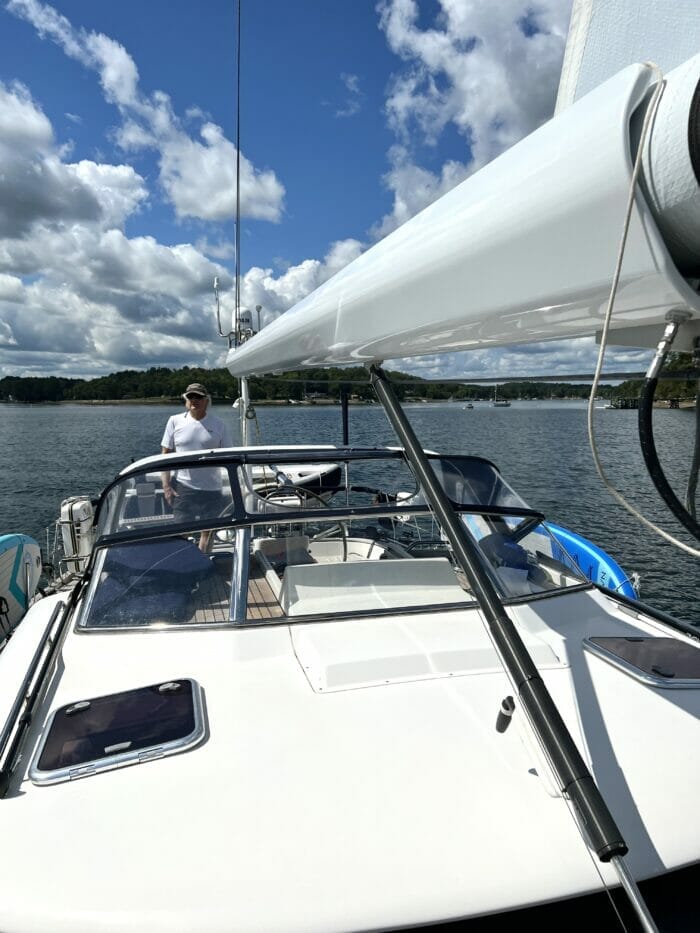
My friend Hans, who advised me while I was writing the article on the tragedy aboard Escape, took me out on his Farr 56 for a demo of hoisting, reefing, and furling, using his in-boom automated mainsail-handling system.
Hans is an incredible resource, since he has owned boats with slab, in-mast, and in-boom furling, as well as being a deeply experienced ocean sailor, including countless trips to and from the Caribbean over decades, and five trans-Atlantics in the last few years—two with slab reefing, two with in-mast, one with in-boom.
I will be sharing his wisdom on all three systems and how to choose which is best for each of us, in an in-depth article.

I’ve enjoyed a leisurefurl boom on a pair of Hinckley yachts- 42 and 51 for 14 seasons. The system works terrific and has never jammed restricting getting the mainsail up or down. There is definitely a learning curve remembering the clutch and winch use as the sail goes up or furls down. We completed in early July a transatlantic from Bermuda. We reefed many times with the sail and boom at the angle of a broad reach and NEVER had to come up into the wind and waves to get the sail furled
Hi Paul,
Good to hear, do you have any tips for exactly how you got it to work on a broad reach. And does your unit have the motor on the aft end of the boom, or through the mast with an articulating shaft?
Hi John,
The LeisureFurl boom has a furling drum either in front of the mast or at the back of the boom, directly connected to the mandrel.As far as I know they all have the shaft through the mast and the articulating universal joint at the back of the mast.
There is a motorised version that seems to fit at the back of the boom/mandrel, but I’m not sure why anyone would want to add the extra weight to the end of the boom (worst place)? Or put electrics into such an exposed place?
We have the furling drum at the end of the boom as we store our spinnaker pole in front of the mast, and like Paul we have a cabin top electric self-tailing halyard winch. This is a help as it enables a crew member to operate it whilst easily keeping an eye on the sail as it goes up or down.
A nice feature of the LeisureFurl implementation, is in front of the mast there is a hub which can take a socket for a winch handle that can be inserted and the sail manually wound down or up if the furling line fails or jams (if jammed you would cut the furling line first).
One trick we found for furling downwind is tying the sail slightly further aft on the mandrel (say 20 mm) which gives slightly more clearance, and helps prevent the sail bunching up at the mast.
Hi Rob,
Hans’s unit does not have the shaft through the mast and relies on a motor in the aft end of the boom driving the mandrel. As I understand it, this is the preferred solution on larger boats because it gets rid of the articulating shaft which would be under huge and strange loads, that get way worse as the boom goes out, on a boat the size of Hans’s. I will have to check with him on manual backups, thanks.
Thanks John, that makes more sense now. The mandrel must have the hub and a bearing at the front of the boom.
Glad you’re finally looking more closely at this technology. We look forward to your review. We’ve also had the Leisurefurl on our Brewer 44 for the last three years full time. No problem furling off the wind. Love it.
Hi Gino and Paul,
Can I ask what is the most wind you have reefed in downwind broad reaching? For us we have reefed this way in a little under 30 knots, but we had our Code 0 up and were surfing at around 13 ->15 knots, so the apparent wind was only about 15 knots across the sails. Thanks. Rob
The system is powered with a single electric winch in the cabin top. We use a batten on the hydraulic vang to set the boom angle which becomes more critical when broad reaching and furling. We lower the halyard with considerable back pressure matching the furling mandrel. With slow progress furling doesn’t bind up.